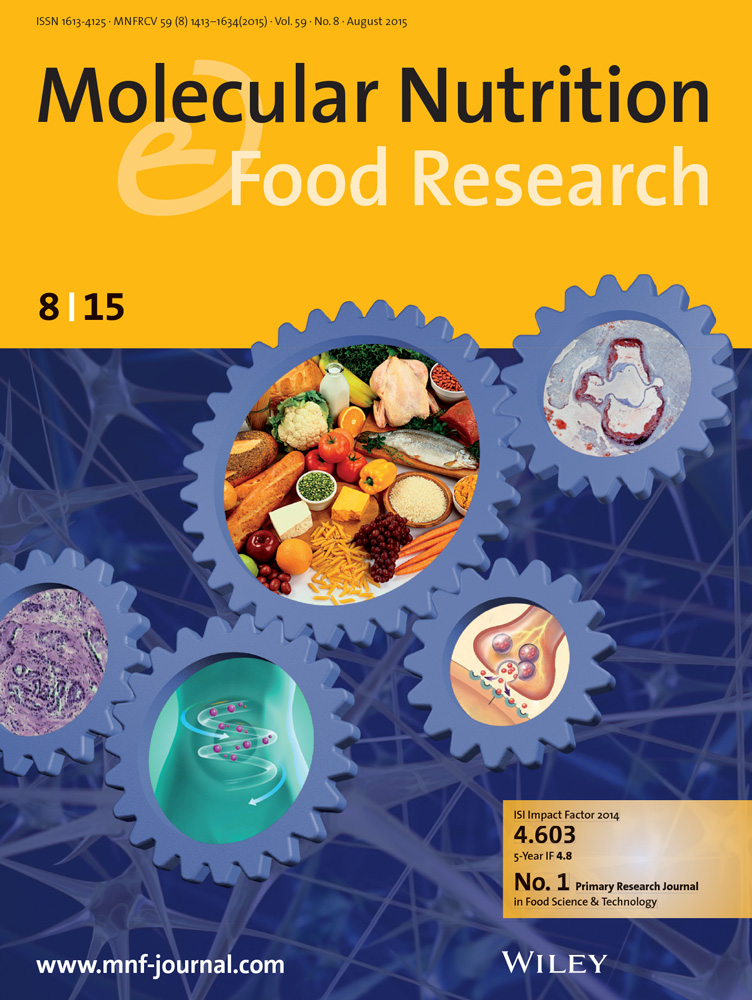Changes in Liver Metabolome Induced by Pterostilbene and Resveratrol in a Rat Model of Liver Steatosis
IF 4.5
2区 农林科学
Q1 FOOD SCIENCE & TECHNOLOGY
引用次数: 0
Abstract
To gain more light on the effects of resveratrol and pterostilbene in the hepatic metabolic modifications in an in vivo model of diet-induced hepatic steatosis, and to explore their relationships with gut microbiota by untargeted metabolomics and metagenomics. Rats were divided into five groups receiving either a standard diet or a high-fat high-fructose (HFHF) diet supplemented or not with pterostilbene (15 or 30 mg/kg body weight/day; PT15 or PT30 groups, respectively) or resveratrol (30 mg/kg body weight/day; RSV30 group). Supplementation with the stilbenes reduced the hepatic steatosis induced by the HFHF diet. After the metabolomics study, 27 differentially expressed metabolites showed variable importance in projection scores > 1 and could be considered as potential biomarkers. Therefore, based on the pathway enrichment analysis, “riboflavin metabolism” and “nicotinate and nicotinamide metabolism” revealed significant enrichment. Further, riboflavin showed positive correlations to Eubacterium and Faecalibacterium, and negative correlations to Lactobacillus and Oscillospira genera. Nicotinamide mononucleotide was only positively correlated to the Ralstonia genus. The untargeted metabolomics approach showed that the actions of resveratrol or pterostilbene on the prevention of liver steatosis are mediated by specific mechanisms of action. Particularly, pterostilbene, but not resveratrol, is suggested to significantly enrich riboflavin or nicotinate and nicotinamide metabolic pathways.

紫檀芪和白藜芦醇对肝脂肪变性大鼠肝脏代谢组的影响
通过非靶向代谢组学和宏基因组学研究白藜芦醇和紫菀芪在饮食诱导肝脂肪变性体内模型中肝脏代谢改变中的作用,并探讨其与肠道微生物群的关系。将大鼠分为五组,分别饲喂标准饮食和高脂高果糖饮食(hhff),并在饮食中添加或不添加紫檀芪(15或30 mg/kg体重/天;PT15或PT30组)或白藜芦醇(30 mg/kg体重/天;RSV30集团)。添加二苯乙烯可减少HFHF日粮引起的肝脏脂肪变性。代谢组学研究后,27种差异表达的代谢物在预测评分中表现出不同的重要性>;1,可以被认为是潜在的生物标志物。因此,基于通路富集分析,“核黄素代谢”和“烟酸和烟酰胺代谢”显示显著富集。核黄素与真杆菌和粪杆菌呈显著正相关,与乳杆菌和示波螺旋菌呈显著负相关。烟酰胺单核苷酸仅与Ralstonia属呈正相关。非靶向代谢组学方法表明,白藜芦醇或紫檀芪对肝脏脂肪变性的预防作用是通过特定的作用机制介导的。特别是,紫檀芪,而不是白藜芦醇,被认为是显著丰富核黄素或烟酸和烟酰胺代谢途径。
本文章由计算机程序翻译,如有差异,请以英文原文为准。
求助全文
约1分钟内获得全文
求助全文
来源期刊

Molecular Nutrition & Food Research
工程技术-食品科技
CiteScore
8.70
自引率
1.90%
发文量
250
审稿时长
1.7 months
期刊介绍:
Molecular Nutrition & Food Research is a primary research journal devoted to health, safety and all aspects of molecular nutrition such as nutritional biochemistry, nutrigenomics and metabolomics aiming to link the information arising from related disciplines:
Bioactivity: Nutritional and medical effects of food constituents including bioavailability and kinetics.
Immunology: Understanding the interactions of food and the immune system.
Microbiology: Food spoilage, food pathogens, chemical and physical approaches of fermented foods and novel microbial processes.
Chemistry: Isolation and analysis of bioactive food ingredients while considering environmental aspects.
 求助内容:
求助内容: 应助结果提醒方式:
应助结果提醒方式:


